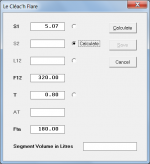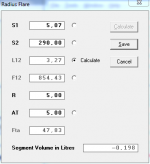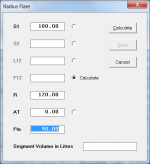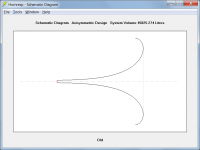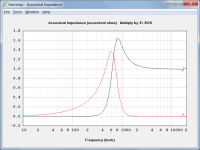Can't get Rad to work.
"Radius horn flare can not be less than *cm"
It keeps increasing then I try to match the value and often go bonkers with unrealistic values.
Still should that not be "can not be more than" as you can not go above a certain length to match 90* and refer to length instead?
Or simply grey ether area or length out as one is determined by the other, or am I missing something?
"Radius horn flare can not be less than *cm"
It keeps increasing then I try to match the value and often go bonkers with unrealistic values.
Still should that not be "can not be more than" as you can not go above a certain length to match 90* and refer to length instead?
Or simply grey ether area or length out as one is determined by the other, or am I missing something?
Hi David
Inspired by Astos biradial wood horns I have started designing a radial horn using two different lecleach curves:
Could you consider adding support for radial horns in the future?
Inspired by Astos biradial wood horns I have started designing a radial horn using two different lecleach curves:
An externally hosted image should be here but it was not working when we last tested it.
Could you consider adding support for radial horns in the future?
Hi more10,
I changed my computer’s regional setting to the Swedish number format, entered the Le Cléac'h horn parameter values shown in your screenprint and then selected the System Design With Driver tools menu command. Everything worked fine for me - I do not get the error message you are seeing.
Because of the way that the Le Cléac'h horn profile is generated, it is not possible to directly specify the L12 value as an input parameter. You may find it easier to use the Horn Segment Wizard to specify a Le Cléac'h design - see attached example screenprint.
Kind regards,
David
When hitting
I changed my computer’s regional setting to the Swedish number format, entered the Le Cléac'h horn parameter values shown in your screenprint and then selected the System Design With Driver tools menu command. Everything worked fine for me - I do not get the error message you are seeing.
As you can see, the L12 field is not editable:
Because of the way that the Le Cléac'h horn profile is generated, it is not possible to directly specify the L12 value as an input parameter. You may find it easier to use the Horn Segment Wizard to specify a Le Cléac'h design - see attached example screenprint.
Kind regards,
David
Attachments
Can't get Rad to work.
Hi David_Web,
From your description of the problem I suspect that you might be increasing the value of Rad (the horn axial length) rather than the value of R (the flare profile radius). If this is not the case could you please let me know.
Kind regards,
David
Could you consider adding support for radial horns in the future?
Hi more10,
Sorry - it's not going to happen 🙂.
Hornresp is limited to axisymmetric horns only.
Kind regards,
David
Because of the way that the Le Cléac'h horn profile is generated, it is not possible to directly specify the L12 value as an input parameter.
I was trying to change from Lec to Rad, but coultn't. Thats why I tried "system design/with driver".
You should add a function preventing Hornresp from running at night 
Didn't even see the R parameter

Didn't even see the R parameter

You should add a function preventing Hornresp from running at night
Don't they experiment with algorithms to determine if you are too sleepy/tired/etc to drive? Hornresp could include an algorithm to determine your state of alertness, and shut down if you are too tired 🙂
-Bjørn
Yet Another Alternative Horn Curve
Hi David
For an additional option you may want to consider Cornu's spiral. It is a plane curve whose curvature is proportional to its arc length, and whose Cartesian coordinates are given in parametric form by the Fresnel integrals. Also known as a clothoid; Euler's spiral it is similar in form to JMLC’s method of determining horn wall geometry. I suspect that one may well be a parameterization of the other. For details see: Euler's spiral
Regards,
Bill
Hi David
For an additional option you may want to consider Cornu's spiral. It is a plane curve whose curvature is proportional to its arc length, and whose Cartesian coordinates are given in parametric form by the Fresnel integrals. Also known as a clothoid; Euler's spiral it is similar in form to JMLC’s method of determining horn wall geometry. I suspect that one may well be a parameterization of the other. For details see: Euler's spiral
Regards,
Bill
I was trying to change from Lec to Rad, but coultn't.
Hi more10,
To change from Lec to Rad, double-click on the Lec label in edit mode and then press R.
Kind regards,
David
Hornresp could include an algorithm to determine your state of alertness, and shut down if you are too tired 🙂
Or perhaps it could make you a strong cup of coffee instead 🙂.
Can F45 label be used to show mouth angle?
Hi David_Web,
The radius horn mouth flare tangent angle is given by the Fta parameter.
The Horn Segment Wizard enables Fta to be specified as an input value if so desired.
Kind regards,
David
Attachments
The design tool for Rad has a bug in it allowing it to calculate invalid horn with negative volume.
Hi David_Web,
Many thanks for bringing this to my attention - it will be fixed in the next release.
Kind regards,
David
For an additional option you may want to consider Cornu's spiral.
Hi Bill,
Thanks for the suggestion - I suspect that it might be a little too esoteric for Hornresp though 🙂.
Kind regards,
David
... For an additional option you may want to consider Cornu's spiral. ...
Bill,
It is very close to an exponential profile. See here:
http://www.diyaudio.com/forums/full...ornu-spiral-horn-now-you-can.html#post3317645
Hornresp Update 3100-130123
Hi Everyone,
1. Schematic diagram horn profiles are now perfectly symmetrical for all screen resolutions and text size settings. Previously, one-pixel-width "quantisation error" discrepancies could sometimes be seen. The change is purely cosmetic, and the calculated results are not affected in any way.
The attached screenprints show an example of the "old" and "new" profiles. Note the subtle differences - particularly near the throat.
2. The radius horn segment wizard bug reported by David_Web has been fixed.
Kind regards,
David
Hi Everyone,
1. Schematic diagram horn profiles are now perfectly symmetrical for all screen resolutions and text size settings. Previously, one-pixel-width "quantisation error" discrepancies could sometimes be seen. The change is purely cosmetic, and the calculated results are not affected in any way.
The attached screenprints show an example of the "old" and "new" profiles. Note the subtle differences - particularly near the throat.
2. The radius horn segment wizard bug reported by David_Web has been fixed.
Kind regards,
David
Attachments
Hornresp Update 3100-130124
Hi Everyone,
A small spurious spike present at high frequencies in the throat acoustical impedance chart results for some radius horns, has now been eliminated.
See old / new comparison screenprints attached.
Kind regards,
David
Hi Everyone,
A small spurious spike present at high frequencies in the throat acoustical impedance chart results for some radius horns, has now been eliminated.
See old / new comparison screenprints attached.
Kind regards,
David
Attachments
David and others,
could you talk us through what the "shape" of those plots is telling us?
There are some small ripples on the flanks, what do they mean?
There is an asymetry over the peak, what does that mean?
Why does the black have a more pronounced ripple at ~900Hz
What is the difference in the red and the black?
Why the difference in slopes before and after the peak? Red is slow before and fast above, whereas black is fast below and slow above?
Why is the red at zero at both limits whereas the black is zero at low limit and 1 at the high limit? Is it exactly 1? Why 1, what does that mean?
could you talk us through what the "shape" of those plots is telling us?
There are some small ripples on the flanks, what do they mean?
There is an asymetry over the peak, what does that mean?
Why does the black have a more pronounced ripple at ~900Hz
What is the difference in the red and the black?
Why the difference in slopes before and after the peak? Red is slow before and fast above, whereas black is fast below and slow above?
Why is the red at zero at both limits whereas the black is zero at low limit and 1 at the high limit? Is it exactly 1? Why 1, what does that mean?
- Home
- Loudspeakers
- Subwoofers
- Hornresp
